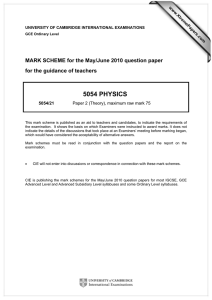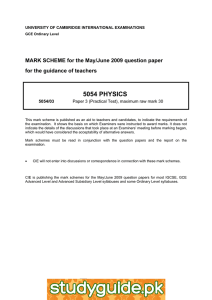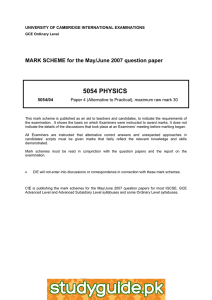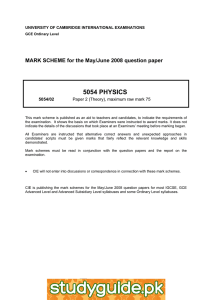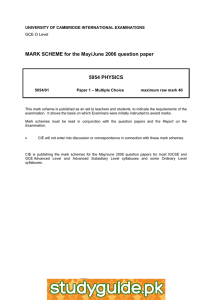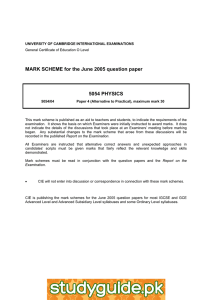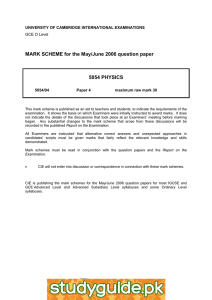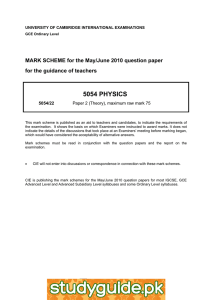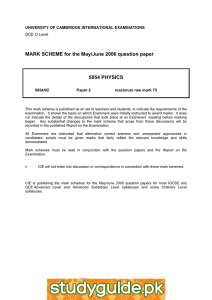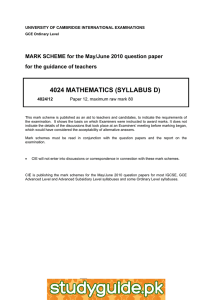5054 PHYSICS MARK SCHEME for the May/June 2010 question paper
advertisement
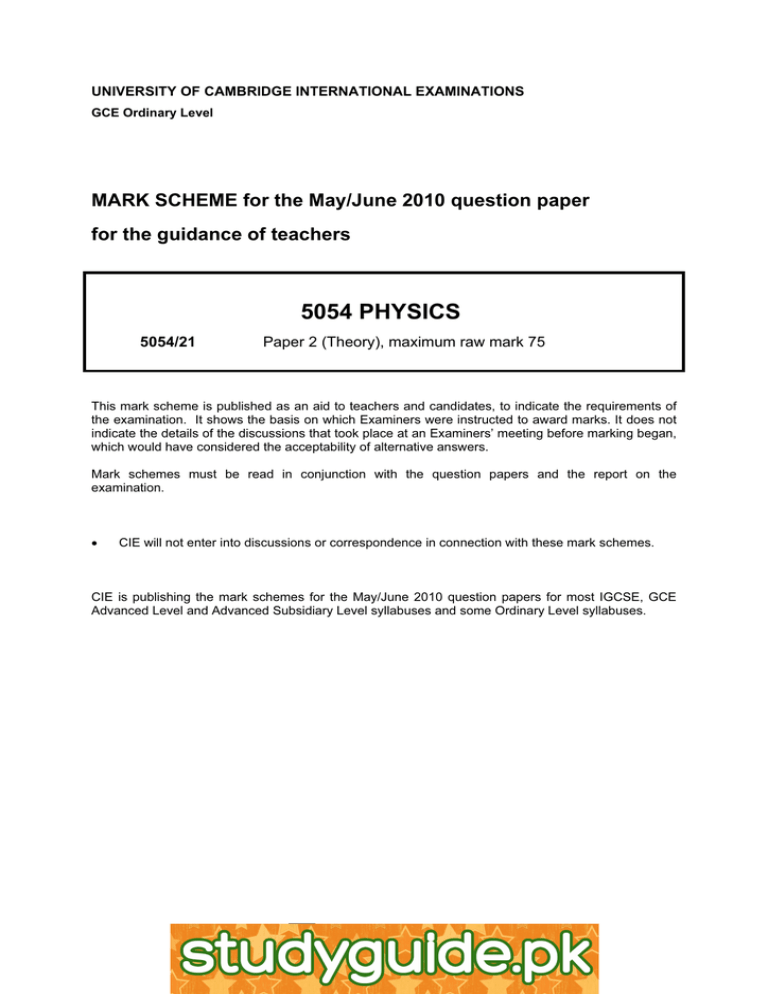
UNIVERSITY OF CAMBRIDGE INTERNATIONAL EXAMINATIONS GCE Ordinary Level MARK SCHEME for the May/June 2010 question paper for the guidance of teachers 5054 PHYSICS 5054/21 Paper 2 (Theory), maximum raw mark 75 This mark scheme is published as an aid to teachers and candidates, to indicate the requirements of the examination. It shows the basis on which Examiners were instructed to award marks. It does not indicate the details of the discussions that took place at an Examiners’ meeting before marking began, which would have considered the acceptability of alternative answers. Mark schemes must be read in conjunction with the question papers and the report on the examination. • CIE will not enter into discussions or correspondence in connection with these mark schemes. CIE is publishing the mark schemes for the May/June 2010 question papers for most IGCSE, GCE Advanced Level and Advanced Subsidiary Level syllabuses and some Ordinary Level syllabuses. www.XtremePapers.net Page 2 Mark Scheme: Teachers’ version GCE O LEVEL – May/June 2010 Syllabus 5054 Paper 21 Section A 1 2 3 (a) forces balance/cancel or no net force or upward force = downward force or weight = air resistance/drag/air friction B1 [1] (b) (i) 9.8–10 m/s2 B1 [1] (ii) a = v(–u)/t algebraic or numerical 2(.0) m/s ecf (i) C1 A1 [2] (iii) straight line from (0,0) to (0.2,2) ecf (ii) after 0.2 s, decreasing but not negative gradient B1 B1 [2] (a) where extension/stretching stops being proportional to force/load/weight/mass or extension/load = constant or point where length or extension against load graph curves C1 [1] (b) 4 = k 6 or 4/6 or 6/4 or 6 × 2/4 or 3 (cm) seen 11 cm C1 A1 [2] (c) different weights/masses/load and measure new length how extension is found e.g. reading on scale for loaded spring subtracted from reading with no load/mass/original B1 B1 [2] (a) chemical energy to or K.E to heat/thermal energy/internal energy – at end B1 B1 [2] (b) friction/resistive force increases B1 [1] (c) (i) work = force × distance in words, number or symbols 1.2 × 0.08 or 0.096 or 20 or 0.208 seen 20.8 or 21 C1 C1 A1 [3] C1 A1 [2] (a) at least 3 reflected wavefronts with same wavelength as before all and [ 2 reflected wavefronts at correct angle B1 B1 [2] (b) (i) no change in direction and clearly smaller, approximately constant wavelength B1 [1] B1 B1 [2] (ii) power = work/time or energy/time, numerical or algebraic – may use values in (i) accept 2/0.2 or 10 W 0.48 W (ecf (i) including power of ten error in (i)) 4 (ii) 1 2 reduces constant © UCLES 2010 www.XtremePapers.net Page 3 5 Mark Scheme: Teachers’ version GCE O LEVEL – May/June 2010 Syllabus 5054 (a) (i) correct direction of refraction at both faces (not along normal) blue below red and blue and red diverge B1 B1 [2] B1 [1] B1 [1] B1 [1] (a) variable resistor or rheostat B1 [1] (b) curved line starting at origin allow straight at first not two straight lines correct curvature from origin with decreasing gradient C1 A1 [2] (c) (i) (resistance) increases (as p.d. increases) B1 [1] B1 [1] (a) (i) I = V/R or 2400 seen 0.0025 A (2.5 mA) C1 A1 [2] (ii) 4 V or 1600 × (i) ecf B1 [1] (ii) any two from orange, yellow, green (b) (i) total internal reflection or angle of incidence greater than critical angle (ii) all colours reflected at same angle or all have i = r 6 (ii) explanation, e.g. lower current than expected for given p.d. or given current needs larger p.d. or correct explanation involving R = V/I accept gradient decreases 7 (b) EITHER capacitor stores charge/charges up/stores energy takes time/delay e.g. voltmeter reading rises slowly/capacitor charges up slowly or to a maximum OR (small) current into transistor/base or large base/emitter voltage (>0.6 V) switches (transistor) on or large current collector/emitter or resistance of transistor reduced 8 Paper 21 B1 B1 B1 B1 [2] (a) meter deflects (one way) changing magnetic field/flux in ring/coil or cutting of flux/field induces voltage/current B1 B1 B1 [3] (b) ammeter returns to/remains at zero B1 [1] (c) ammeter deflects in opposite direction (then returns to zero) field decreases/change in opposite direction or field/flux cuts in opposite direction B1 B1 [2] © UCLES 2010 www.XtremePapers.net Page 4 Mark Scheme: Teachers’ version GCE O LEVEL – May/June 2010 Syllabus 5054 Paper 21 Section B 9 (a) (i) 120°C or –10°C to 110°C B1 [1] (ii) longer thermometer or wider bore or less mercury or smaller bulb not change liquid B1 [1] (b) (i) measures small(er) change in temperature or small(er) range for same distance or large(r) expansion for (same) temperature rise B1 [1] (ii) larger bulb or more liquid or narrower bore/tube or use liquid that expands more B1 [1] (c) constriction/narrowing (accept 1st and 3rd marks on diagram) mercury/thread breaks at constriction (on cooling) or thermometer is a “maximum” thermometer range different more sensitive/divisions further apart triangular cross-section/acts as lens thin(ner) bulb (quick response to temperature change) ANY 3 lines B3 [3] (d) (i) two different metals joined connected to meter/ammeter/galvanometer/voltmeter M1 A1 [2] B2 [2] C1 A1 [2] C1 A1 [2] (ii) low/high temperatures or greater range responds quickly/measures rapidly changing temperatures measures temperature at a point electronic output more robust measures temperatures at a distance (not more sensitive) ANY 2 lines (e) (i) (Q =) Pt or 80 × 5 × 60 or 80 × 5 or 400 or 300 (s) seen 24000 J cao (ii) (Q =) mc∆T or 1.8 × 390 × T = 24000 in any form ecf (i) 34°C (accept 34.188, 34.18, 34.19, 34.2) © UCLES 2010 www.XtremePapers.net Page 5 Mark Scheme: Teachers’ version GCE O LEVEL – May/June 2010 Syllabus 5054 10 (a) (master cylinder creates) pressure in brake fluid or pressure from master piston transmitted to slave piston fluid/pressure produces force/push (not press) (on slave piston) or force from master piston transmitted (to slave piston) Paper 21 B1 B1 [2] C1 A1 [2] (ii) 70 × 2.8 200 N accept 196 N ecf (i) C1 A1 [2] (iii) distance foot to pivot larger than piston to pivot force × distance constant B1 B1 [2] B1 [1] (ii) hit more often/more frequently (accept hit each other more often) smaller volume or molecules closer/less space B1 B1 [2] (iii) P1V1 = P2V2 or PV = constant 1 × 105 × 6 (×2) = P × 4 × (2) 1.5 × 105 Pa B1 C1 A1 [3] B1 [1] (b) (i) P = F/A or 140/2.0 70 (N/cm2) (c) (i) molecules hit against walls/piston (ignore hit each other) (d) air/bubbles compress/reduce in volume or brakes pushed further/spongy ignore: efficiency; less pressure; less force transmitted © UCLES 2010 www.XtremePapers.net Page 6 Mark Scheme: Teachers’ version GCE O LEVEL – May/June 2010 Syllabus 5054 11 (a) electron negative electromagnetic (high frequency wave/particle/photon) neutral/none (b) (i) time taken to halve activity or number of atoms/nuclei or count (rate) (ignore radioactivity/mass/volume/amount/number of particles/molecules/ a nucleus to halve) (ii) alpha stopped by body/flesh/skin or cannot penetrate body/skin or causes damage to body (1 max for damage) gamma penetrates body/not absorbed or can be detected outside body or causes less/no damage to body (1 max for damage) Paper 21 B1 B1 B1 B1 [4] M1 A1 [2] B1 B1 [2] (iii) takes time for isotope to spread/investigation/experiment (so 6 min too short) B1 [1] (iv) radioactive for longer/more dangerous/more damage/causes damage B1 [1] B1 [1] (ii) 3200 seen (as average) attempt to halve e.g. 3202 → 1601 or 4 half-lives 52 hours C1 C1 A1 [3] (iii) rocks/cosmic rays/radon gas/nuclear fall out B1 [1] (c) (i) (radioactive emission is) random © UCLES 2010 www.XtremePapers.net
